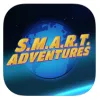Take a look inside 5 images
SMART Adventures Mission Math 1: Sabotage at the Space Station
Pros: Story-based game makes learning about math fun, and empowers kids to practice at their own pace.
Cons: The game may not provide enough practice for kids who need to focus heavily on specific skills.
Bottom Line: Engaging math practice tool covers a variety of topics, but could provide more in-depth content coverage.
SMART Aventures Mission Math 1 is an engaging way to review and reinforce math skills. You could use it at the start of the school year to determine what kids know and remember from the previous year. Have kids work individually to complete the mission over a series of days, making note of any specific content they struggle with. Then review a few problems from each mini-game as a class and address questions as needed. Another option would be to use the mini-games throughout the school year as a way for kids to practice skills they're learning in the classroom.
The game begins with a story about a space station and an invitation for kids to help with a mission. Kids choose an avatar and are introduced to different characters aboard the space station. They then begin exploring different parts of the space station, which has five main corridors and different labs on each corridor. Kids choose a corridor, then a lab, and play math mini-games in the lab. Each mini-game begins with on-screen instructions and an animated tutorial. Games aren't timed, but kids have to correctly solve a certain number of problems to complete each game. As the game progresses, kids learn more about their mission and get closer and closer to solving the mystery.
SMART Adventures Mission Math 1: Sabotage at the Space Station is a story-based math game that takes place aboard a sabotaged space station. Kids solve math problems to repair damaged labs and discover who's responsible for the sabotage. As they try to solve the mystery, kids play mini-games involving a variety of math content. They also solve problems related to scientific experiments, space travel, chemistry, and more. Games cover such concepts as fractions, decimals, measurement, place value, graphing, geometry, and multiples. Kids can move around various parts of the space station; each area focuses on a different skill set. For example, in the biology lab, kids work with place value. In the robot lab, they work with angle measures, parallel and perpendicular lines, and 3-D shapes.
Kids aren't penalized for getting answers wrong, but they must correctly solve a certain number of problems before completing a mission. Each mission has three levels of difficulty, so kids are challenged as they continue to play. Because of the wide range in content, however, kids don't get in-depth practice with any particular skill. In addition, no feedback or hints are provided for incorrect answers, so the game is best suited for practice rather than instruction.












